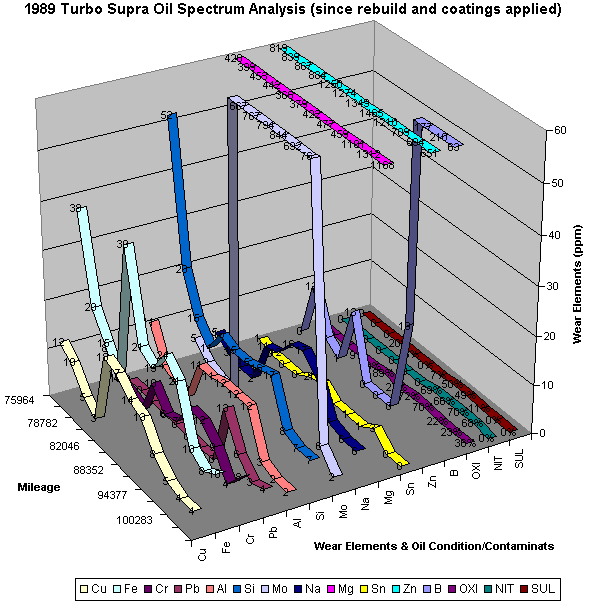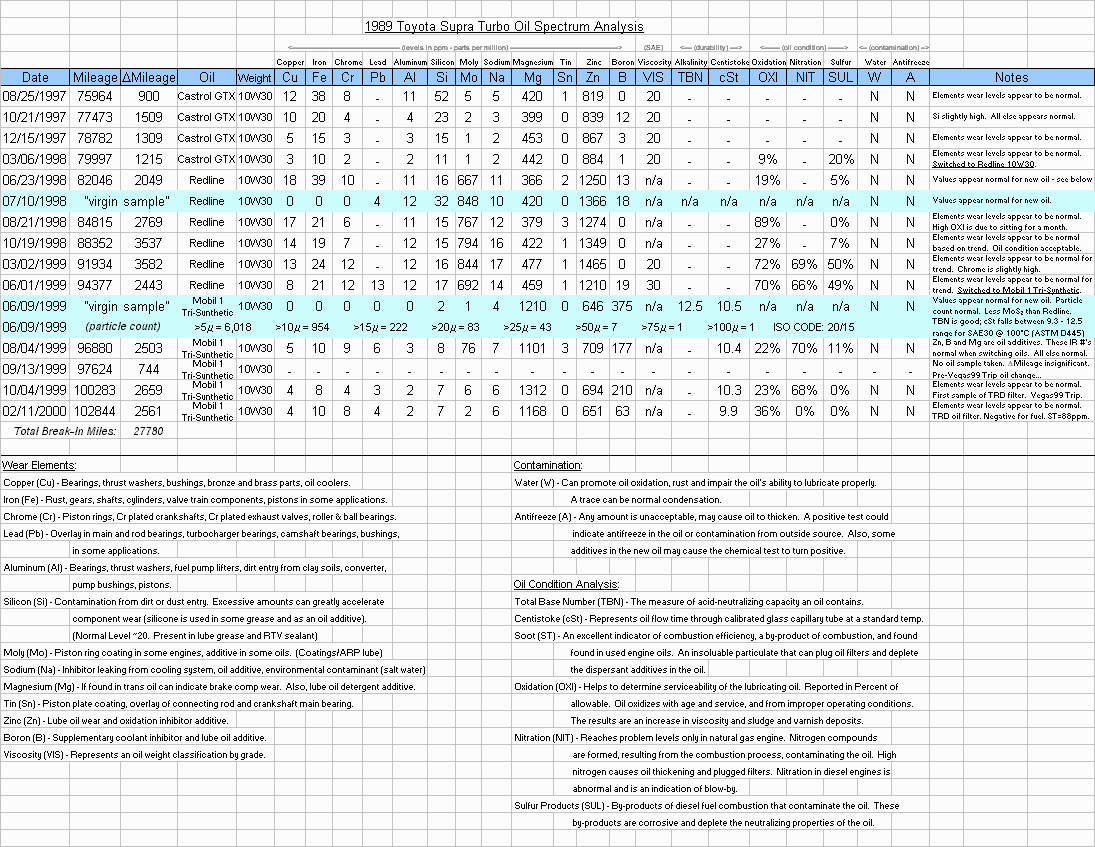Oil Spectrum Analysis Data | 
Click for Tri-Synthetic Product Data Sheet |
Click to go directly to the data... |
Oil Spectrum Analysis Data | 
Click for Tri-Synthetic Product Data Sheet |
Click to go directly to the data... |
What's New | Background | 3-D Results Plot | The Data |
The other thing was the apparent increase in wear metals. Strange for an oil with half the coefficient of friction of Mobil 1, but then it hit me. I did the exhaust manifold helicoiling on this batch. These samples are 'very' easily contaminated as they are so sensitive. The next sampling should settle this issue. The engine 'is' still breaking in. 7M motors are low friction motors and according to Turbo magazine can take upwards of 30k to fully break in. So perhaps Redline affects the break-in process differently. We'll see.
Lastly, I found it odd that the aluminum levels were slightly higher. I found out that this 'can' be an additive. Aluminum's much greater thermal conductivity can be used to increase heat transfer to the oil and aid in the oil's ability as a coolant. As long as the concentration doesn't get too high (since aluminum is a crystalline structure and can become a wear particle), it can actually do good here. I can't wait for the next sampling.
To make sure my coatings were intact and to put my mind completely at ease, I ran an analysis on a 'virgin' sample of Redline 10W30. The results are shown below and were pleasing. Aluminum was dead on for the virgin sample and used sample and moly was actually higher in the virgin sample, which meant, if anything, that moly was being deposited on the bearing surfaces. Cool...
Note: This sampling marked a switch from a Level I test to Level II testing. Basically, this adds two additional tests -- Oil Oxidation Percentage as well as Sulfur Products. This will give even more data on the oil's condition. I figured it was a good time since I can do a direct comparison of a good regular dino oil to Redline using the same test. The results for the Castrol were implemented into the chart and graph below.
Background
When rebuilding an engine, it's vital to make sure that all the seals and bearings seat properly to ensure a long and healthy life in the torture chamber known as the internal combustion engine. If the rings don't seat correctly or completely you'll have eternal blow-by and a resulting loss of compression and power plus you'll burn oil. If the main bearings don't seat properly you'll run the risk of spinning a bearing which will utterly ruin your day. The list of possible tragedies goes on and on... But there is a way to peer into the inner workings of your engine in a non-invasive manner. It's called a spectrum analysis.
Basically (without getting into any details on the process) the used engine oil, which you sample during an oil change, is passed through a spectrum analyzer which will tell you the various particulates present in suspension in the sample. Each element can tell you a different thing about what's going on between oil changes. I made a simple info table below the data to explain what each value could mean. Also, they'll do a check for water and antifreeze which is like getting the head gasket integrity checked at every oil change.
My primary reason for doing this is to get a feel for when the motor is completely broken in and ready to accept synthetic oil (i.e. Redline, Mobil 1, Amsoil, etc.). If you switch over to synthetic oil too quickly, the slickness of the oil won't allow proper break in of the rings and you'll burn oil. On the other hand, you want to switch over as quickly as you can due to all the benefits such an oil adds. The coefficient of friction is much less, the resistance to coking is much higher, foaming is reduced, shear loads are higher, thermal breakdown resistance is greater, etc.
I know someone who switched over too soon and was also using Total Seal Rings, which in themselves have much tighter tolerances and must have extra care taken when using them. He switched over to synthetic after a couple hundred miles on his motor so he could run it in a race. He ended up creating a big plume of burned oil whenever he stepped on it. And sure, you may be asking if you can simply switch back. Well sure, but remember you'll have dilution of synthetic and normal dino oil this way since you'll never get it all completely out for at least a couple of oil changes.
Anyways, since people have been asking me about this, I decided to publish the data i've compiled so far as well as my graphs. I have everything entered into Excel 8.0 and generated a three dimensional graph to show all the data at once. The new Excel really does excel at this :-)
Since this data will be updated as I get more done, I've included a graphical link up top to allow you to quickly drop down to the data since this background data shouldn't change much... Here we go:


On the off-chance that you don't have the plug-in for the Acrobat Reader, here's the link to Adobe to get the latest one:
 Head
back to my mods page...
Head
back to my mods page...